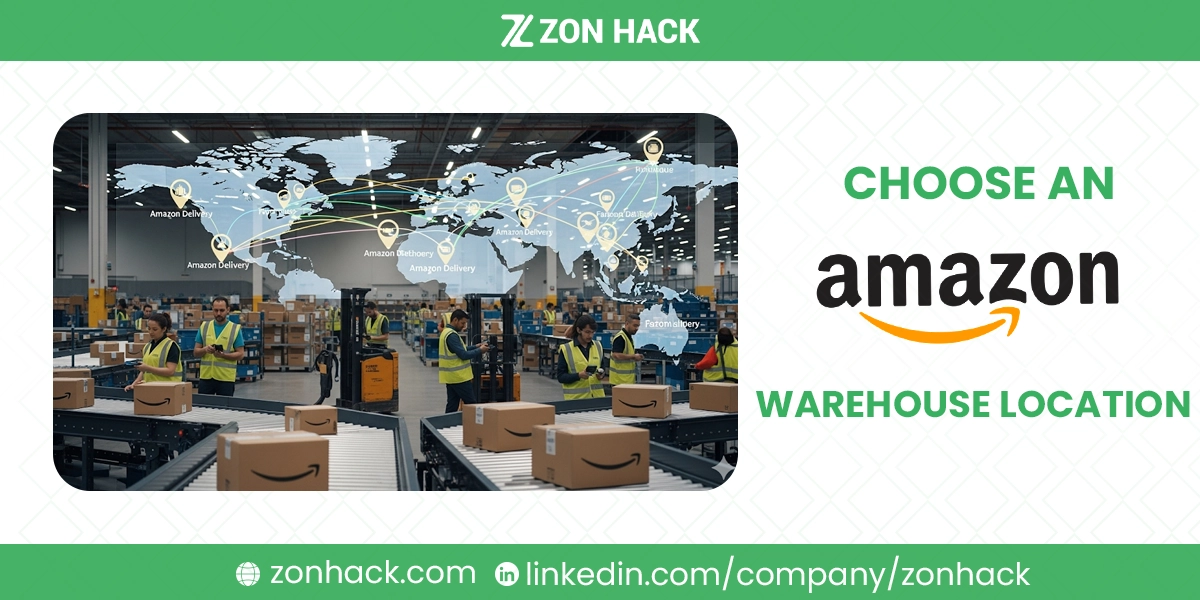If you’ve ever sold on Amazon or thought about it, you’ve probably asked yourself: Where will Amazon store my products? It’s a fair question. After all, location has a direct impact on shipping speed, costs, and customer satisfaction.
Here’s the catch: sellers don’t get to pick the exact warehouse where their inventory goes. Amazon has its own massive fulfillment network and uses smart systems to assign inventory to the right place. But don’t worry—once you understand how it works, you’ll see that it’s actually a good thing for your business.
Things Sellers Need to Know About Choosing an Amazon Warehouse Location
Sellers can’t just tell Amazon where to send their stuff. It’s a common misconception, and I get why. We want control over our businesses, right? But with FBA, that control is traded for the power of Amazon’s logistics network. Their system automatically assigns your inventory to the best warehouse locations. It’s all about optimizing for distribution and making sure your products can reach customers across the country—or even the world—in record time.
Knowing how this system works is key to managing your own logistics and replenishment. When you create a shipping plan, Amazon’s system might tell you to send your inventory to one location, or it might split it up and ask you to ship to several different warehouses. This might seem annoying, but it’s done for a good reason. By spreading your products out, Amazon can promise fast shipping to a wider range of customers, which often translates to more sales for you. If you know that Amazon’s fulfillment centers are often located in major US regions like New Jersey, Florida, Illinois, Texas, California, Oregon, and Washington, you can better estimate your shipping costs when sending your goods from your own location or from your supplier.
How Amazon Chooses Warehouse Locations
Ever wonder what goes on inside Amazon’s brain when they’re deciding to build a new warehouse? It’s not just a random dart throw on a map. Amazon uses a set of very specific and highly researched criteria to choose its warehouse locations. They are all about efficiency and speed, and every decision is made to optimize their fulfillment network.
Customer Proximity and Population Density
This is probably the most important factor. Amazon builds warehouses near big cities and densely populated areas. Why? It’s simple: the closer your products are to the customers, the faster they can be delivered. This is how Amazon can offer amazing services like same-day or next-day shipping. It’s a huge part of their business model and a major reason why customers love shopping with them. Fast delivery equals happy customers, and happy customers keep coming back.
Technological Infrastructure
You can’t run a super-advanced warehouse on old technology. Amazon’s fulfillment centers are a marvel of modern tech, full of robots, automated conveyor belts, and sophisticated inventory management systems. All of this requires a rock-solid technological infrastructure. This includes reliable high-speed internet, consistent power, and the ability to support massive, complex systems without a hitch. A location with a weak technological backbone just wouldn’t cut it.
Transportation Infrastructure
A warehouse is only as good as its connections. Amazon needs locations that are like the nerve centers of a country’s transportation system. This means being close to major highways for truck freight, airports for their own Prime Air cargo planes, railroads, and even seaports for international shipments. Having these connections nearby allows for super-efficient inbound and outbound logistics. It helps them reduce shipping costs and keeps transit times low, which is a win for both them and us, the sellers.
Market Demand
Amazon is a data-driven company, so they place their warehouses in regions where people are doing a lot of online shopping. By studying where demand is highest, they can make sure they have a local fulfillment center to meet those needs quickly. For example, if a region is experiencing a surge in online sales, you can bet Amazon is looking at that area for a potential new facility. They want to be able to fulfill orders in a flash, and being close to high-demand markets is the way to do it.
Cost of Real Estate
Of course, it’s not all about speed. Money talks, too. Amazon has to balance its strategic location needs with the cost of real estate. A prime piece of land in a major urban center can be incredibly expensive. So, they have to find a sweet spot—a place that’s close enough to customers to be effective, but not so expensive that the operational costs become unmanageable. They also need a lot of land, so finding a large, affordable plot is a big part of the puzzle.
Proximity to Suppliers
Finally, Amazon considers where its suppliers are located. Being close to the companies that make the products they sell reduces the time and cost of inbound shipping. This helps them replenish inventory faster and keeps the entire supply chain running smoothly. It’s all about creating a continuous, efficient flow of products from the manufacturer to the customer, and every part of the process is carefully considered.
Conclusion
Choosing an Amazon warehouse location isn’t really in the hands of sellers—but that doesn’t mean you’re left in the dark. Amazon’s system is designed to make sure products reach customers quickly, at the lowest possible cost. By understanding how warehouse locations are selected, you can better estimate your logistics, plan smarter shipments, and avoid surprises.
Remember, speed and efficiency are Amazon’s top priorities, and that’s good news for your business. The faster customers get their orders, the more likely they are to buy again.




